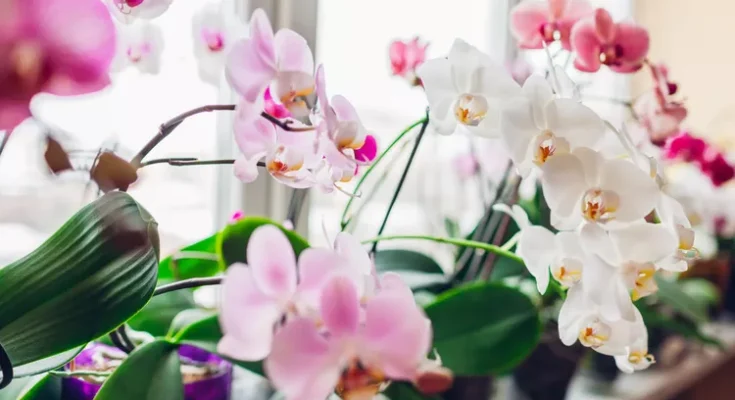Orchids have been a popular houseplant since the Victorian era, when the passion for collecting these tropical beauties reached feverish heights, sending orchid hunters across the world in search of new and rare species.1 Today, orchids remain a favorite plant for gift-giving, as the blooms last for months on end. The most widely available orchids in the garden center belong to the genus Phalaenopsis, or moth orchids, which also happen to be among the easiest to grow. Many people treat orchids like cut flowers, disposing of them after their blooms fade, but they are long-lived and will bloom again under the right conditions. Learn how to grow and care for orchids so you can enjoy these magnificent bloomers for years to come.
Orchid Attributes
Orchid Care
Orchids have a reputation of being difficult to grow. This is certainly true for many orchid species, but not the moth orchids, which are well adapted to growing in the home. An east- or north-facing window provides ideal conditions for orchids, offering plenty of light while protecting plants for direct, intense sun. With proper care, orchids will bloom at least once per year, usually beginning in winter and lasting through spring or early summer. Once they flower, the blossoms can last for four months or longer. Growers in humid climates often take their orchids outdoors for the summer, where they must be kept in the shade.
Light
Orchids perform best with indirect light. including the tailored light from grow lights. A bright east-facing window provides the ideal conditions, though a shaded window facing south or west will also work. Orchids do not tolerate direct, afternoon sun.
Soil
A highly porous potting medium is needed to allow for adequate air and water movement. Orchids are not grown in regular potting soil. They are typically sold in sphagnum moss or bark. When repotting, a potting mix of coarse fir bark or orchid bark is preferred.
Water
Water thoroughly by placing potted plants in a sink and allowing water to flow through the potting medium until damp. Let excess water drain from the container before returning plants to their trays or catch pots. Allow the potting mix to dry slightly before watering again.
Temperature and Humidity
Orchids thrive between 70°F and 80°F during the daytime, and between 60°F and 70°F at night. Cooler temperatures between 55°F and 60°F at night, can help initiate new blooms. Orchids prefer moderate humidity, between 40-60%, which can be achieved by setting pots on moist gravel trays. Be sure the pot itself is not standing in water. Good air circulation helps limit foliar diseases.
Fertilizer
Orchids benefit from regular fertilization. Apply a balanced (10-10-10) fertilizer twice per month at half the recommended rate. Apply fertilizer after watering. A high-phosphorous fertilizer can be used to initiate blooming.
Types of Orchid
Over 60 species of Phalaenopsis orchid are known, and thousands of hybrids have been bred over the years. Most are epiphytic, meaning they grow on trees or rocks, rather than in soil. That is why they need such an airy potting medium. Moth orchids have thick, fleshy evergreen leaves and bloom in a range of colors from pale pink to deep maroon, bright yellow and white, and even lime green. Many are multicolored, striped, or speckled. Some species produce numerous small flowers on branched stems, while others produce fewer but larger blooms. We’ve highlighted a few of the many species and hybrids available.
Phalaenopsis schilleriana
Commonly called Schiller’s pink moth orchid, this species produces large four-inch blooms in white, pink, and mauve hues. Flowers are born on long, arching spikes reaching two to three feet in length. Foliage is flushed purple on the underside for added interest.
Phalaenopsis amabilis
The white moth orchid is easily recognized with its pure white blooms reaching four inches across. Plants often produce two arching floral spikes at the same time, each standing up to three feet tall, for a magnificent display. Individual flowers have rounded petals and a yellow throat.
Phalaenopsis bellina
This compact orchid packs a big punch. Often called Beautiful phalaenopsis, Phalaenopsis bellina is adored for its highly fragrant, citrus-scented blooms. The two-inch, star-shaped flowers top plants stand just three to four inches tall. The flower’s waxy petals are yellow-green or white with fuchsia interiors.
Other Orchids To Grow Indoors
While Phalaenopsis orchids dominate the shelves at box stores and supermarkets, other easy-to-grow orchids can be found at your local florist or greenhouse. Look for the floriferous butterfly orchids, Oncidium species, which produce huge sprays of yellow blooms. Grown as much for its foliage as its blooms, jewel orchid, Ludisia discolor, produces delicate white blooms atop silver streaked foliage. This terrestrial orchid is grown in potting soil rather than bark.
Pruning Orchids
Orchid flowers are produced on long stems called spikes. Each spike produces multiple flowers, with the flowers opening in sequence from the bottom toward the tip of the stem. The flowers along a spike may last for months. When these flowers fall, you have two options for pruning. You can cut the spike off completely, snipping it about one inch above the base. When pruned this way, the orchid directs its energy into producing a new flower spike in several months. If the flower stalk shrivels and turns brown after flowering, cut it back to the base.
Another option is trimming the spike to the second node beneath the current growth. A node is the growing point along the spike, easily identified as a raised or swollen area along the stem. Make your pruning cut just above the node. New growth will emerge from the node, sending out a flower spike in eight to 12 weeks. This secondary growth will likely produce fewer flowers than a fresh spike growing from the base of the plant. A healthy plant can bloom on both the trimmed spike and a new flower spike emerging from the base.
How To Get Orchids To Bloom
You can encourage your orchid to rebloom by giving it the ideal growing conditions to initiate flowering. A 10-degree drop between daytime and nighttime temperatures will signal your orchid plant that it is time to flower. Put your plant in a location where it will experience these temperature fluctuations or place the container in a window where night temperatures tend to be lower (but not too low). You can also change the type of fertilizer to feed plants. When trying to initiate blooms, switch to a high-phosphorous fertilizer such as one with an NPK ratio of 10-30-20. NPK stands for nitrogen, phosphorous, and potassium, the three main nutrients all plants need to grow.
Propagating Orchids
Orchids are not easily grown from seed. If you are lucky, your orchid plant will propagate itself by producing a keiki or baby plant along the flower spike. For this to happen, you must leave your flower spikes standing after the flowers have fallen. Sometimes keiki will also pop up around the base of the mother plant. Wait for the keiki’s roots to grow approximately three inches long before separating it from the mother plant and potting it in a container of its own.
Potting and Repotting Orchids
Repot orchids after they complete a bloom cycle. Orchids do not like to be disturbed, so only repot every two to three years, once you notice the potting medium begin to break down or compact. Use an orchid potting mix or other bark blend. Gently remove the plant from its container and shake off the old potting media. Use sterile scissors or flower snips to prune off any dead or shriveled roots. Orchids like to be crowded in the pot, so replant it in the same container or one of a similar size. Hold the plant by its leaves, allowing the roots to dangle into the pot, then fill around them with bark. Water your newly potted orchid. Repotting may delay the next flower cycle.
Common Problems
If you are new to growing orchids, it can be challenging at first to know when to water. While you want to avoid overwatering, which can cause roots to rot, underwatering can also cause plant stress. The leaves of an underwatered orchid will look shriveled or wrinkled. Interestingly, a plant suffering from root rot may show similar symptoms, because the damaged roots cannot take up enough water to hydrate the foliage.
Remove the plant from its pot and inspect the roots to determine the source of the problem. Gray, shriveled roots indicate a dry plant, while brown, mushy roots are a sign of overwatering. Healthy, well-hydrated roots are plump and green. If underwatering is the problem, give your orchid a long drink. If roots show signs of rot, clip off the damaged roots and repot them in loose bark.
Another common problem with orchids is crown rot. This occurs when water is allowed to sit in the center of the leaves. Avoid this problem by using a towel to wick up any water remaining in the crown after watering.



